Canon EF 24-105/4 L IS vs 24-70/2.8 L
13 Comments
I am often asked for lens recommendations (although I have already wrote a page of technical comments). For those wishing to make photographs similar to mine, and using a Canon full frame camera, I always suggest the Canon 25-105/4 L IS as an all-purpose lens. I consider this lens to be the best zoom ever made by Canon, when used with the appropriate software.
In 2006, after much testing (which will be the subject of a separate post), I replaced my 24-70/2.8, a highly regarded lens which had been my main all-purpose lens, with the 24-105/4. However, as a recent mishap has ruined my 24-105, I’ve been using again the 24-70/2.8 for a few weeks, which reminded me of how much I prefer the 24-105. I am again trying to find a good sample of the 24-105. I thought that would be a good time to share my observations, based on years of use of both lenses.
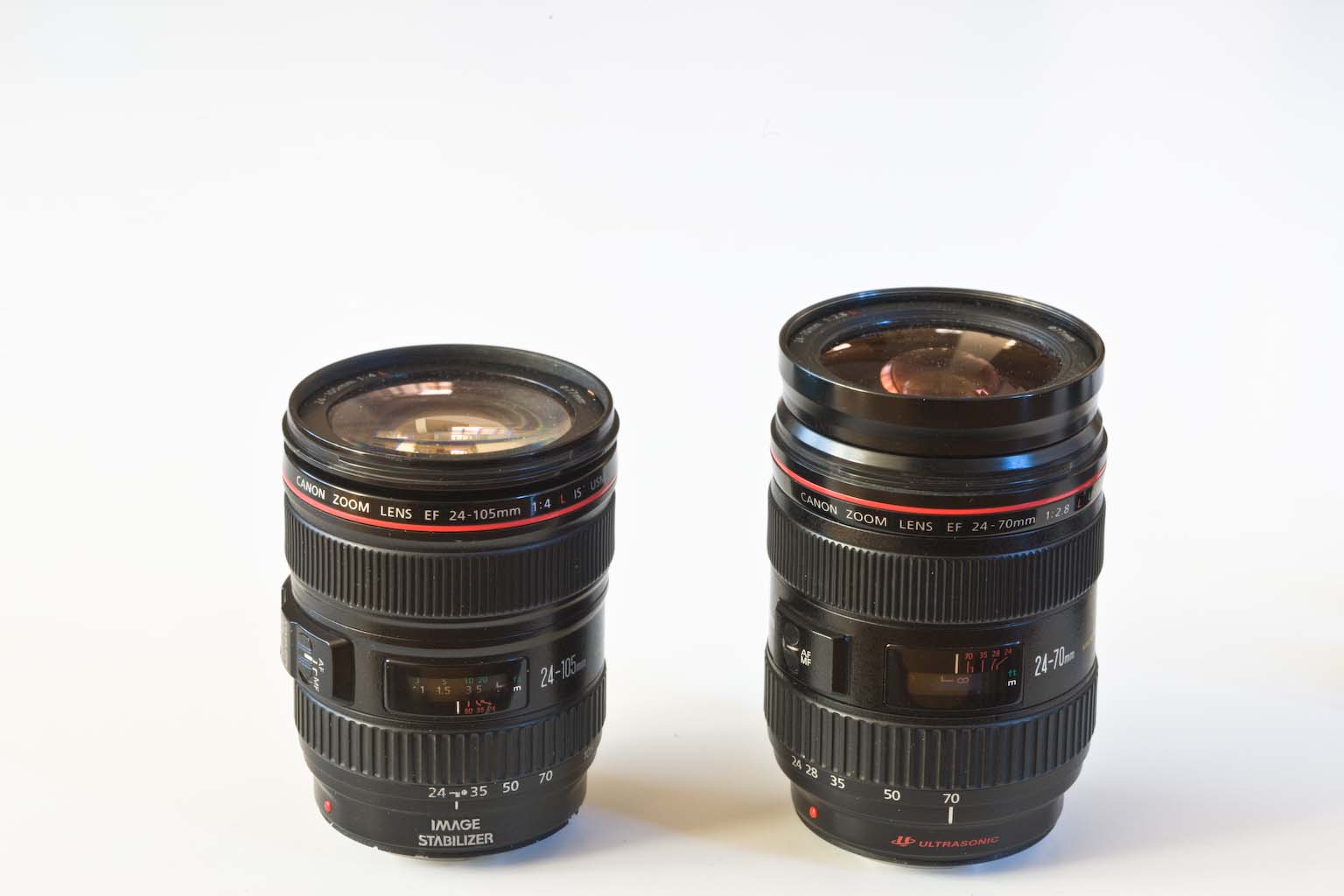
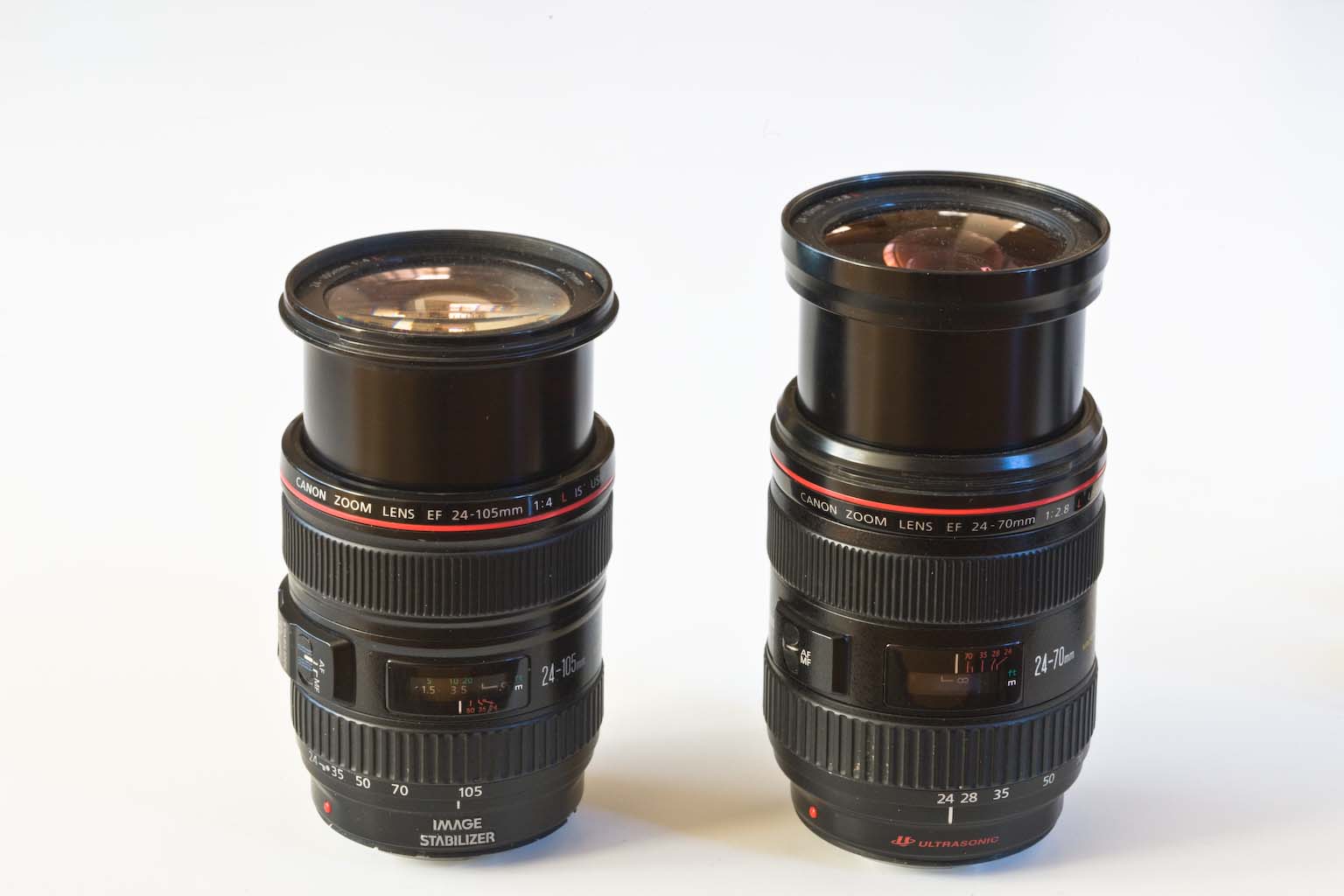
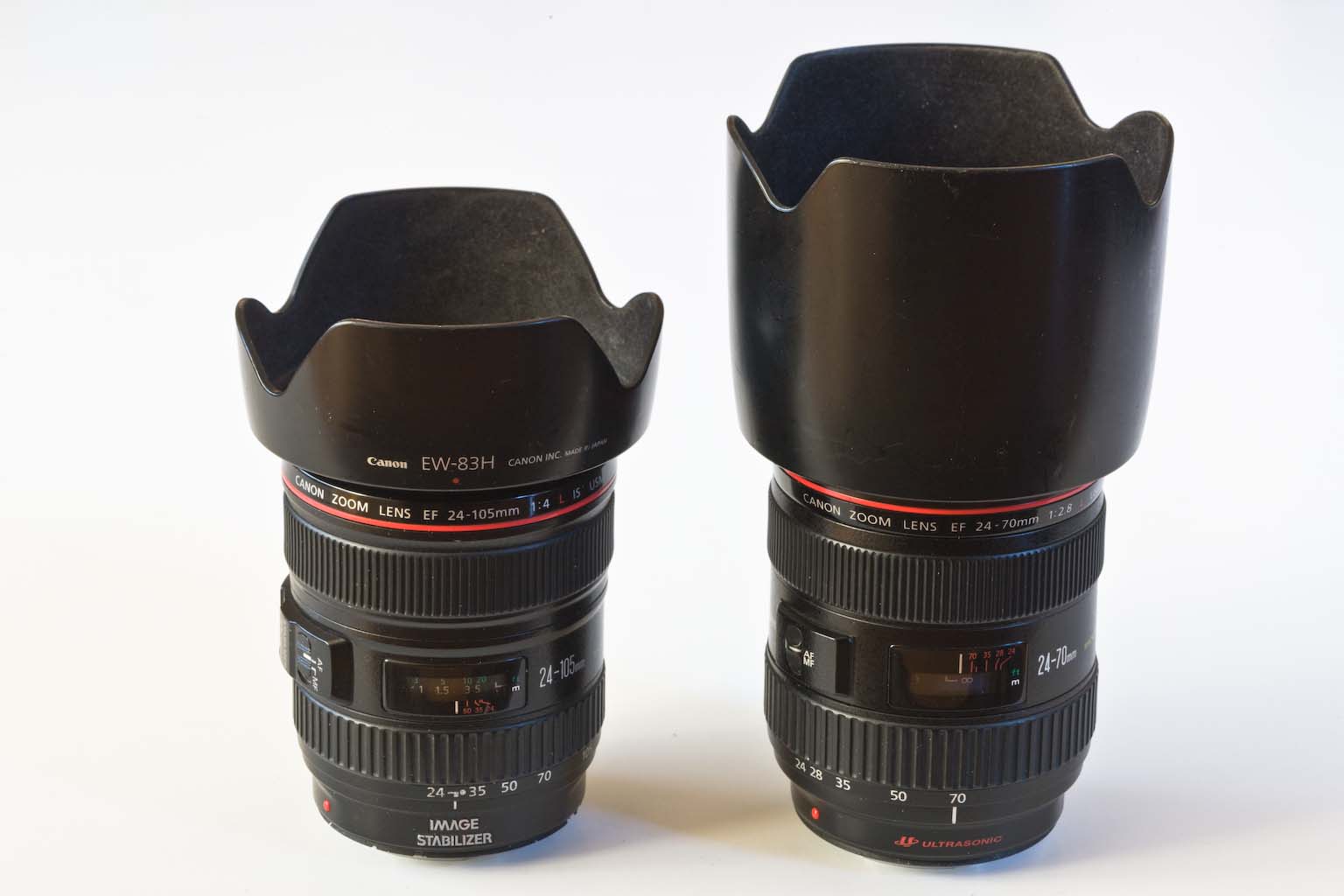
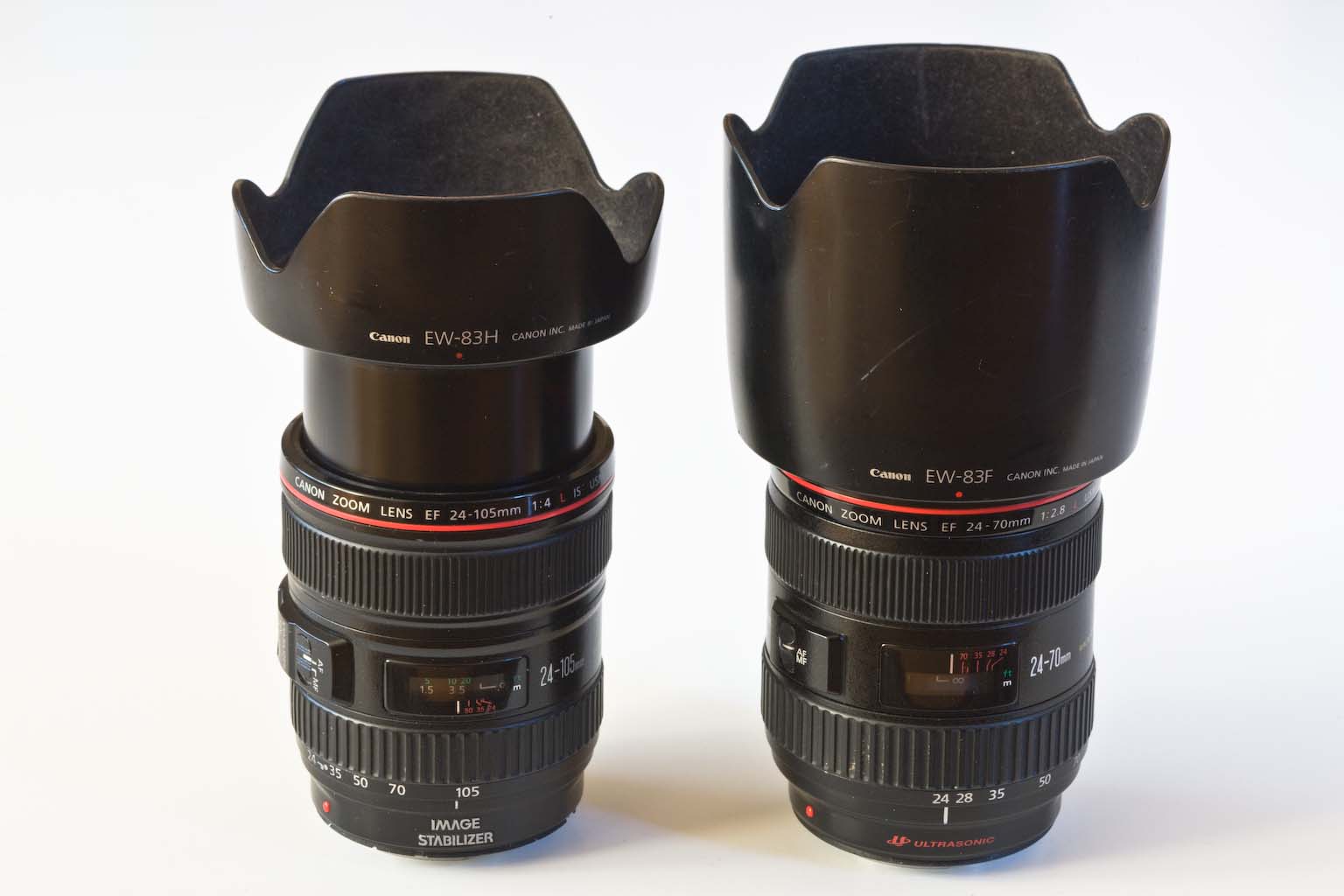
The 24-105 (left) is collapsed @24mm and extended @105mm. The 24-70 (right) is collapsed @70mm and extended @24mm.
| 24-105/f4 IS | 24-70/f2.8 | |
|---|---|---|
| focal lengths | Extra range of 70-105 very useful (for ex. portrait work), or if lens is coupled with 100-400. | |
| max aperture | Extra f-stop of 2.8 useful for moving subjects and blurring backgrounds, brighter viewfinder | |
| close focus | 0.45 / 1.48ft, 0.23x magnification | 0.38m / 1.3ft, 0.29x magnification |
| IS | Image stabilization provides 3 f-stops of stability, more than makes up for max aperture with static subjects, useful for getting more DOF or low light shooting | |
| AF | USM. | USM. Faster and more accurate in low light thanks to f2.8 aperture (many AF cross-sensors are disabled at f4) |
| Size DxL | 83.5 x 107 mm only slightly smaller when used without hood | 83.2 x 123 mm doesn’t include hood, which adds significant bulk |
| Weight | 23.6 oz (670g) significantly lighter | 33.6 oz (950g) | Construction | Sealed. Plastic barrel. | Sealed. Metal barrel. |
| Lens hood | Shallow lens hood attached to extending barrel of lens, optimal only at 24mm. Easily knocked. | Uniquely deep lens hood attached to fixed body of lens, takes advantage of the fact that lens is extended @ 24mm and retracted @ 70mm. Optimal at both 24mm and 70mm. Very efficient and solid, but requires removal to rotate polariser. |
| Zoom creep | long focals, in particular pointed down (annoying for close-ups) | 24-28 range when pointed straight up (rarely used that way) |
| Sharpness | Sharper at all focal lengths and apertures. Excellent wide open at short focal lengths | |
| Vignetting | @24mm: strong (1.5) wide open, mild (0.75) by f8 @50mm: mild wide open, very slight by f8 @105mm: slight wide open, very slight by f8 | @ all focals: slight (0.5 f-stops) wide open, none by f5.6 |
| Distortion | strong barrel @24, slight pincushion @50, moderate pincushion @105 | moderate barrel @24mm, none @50, slight pincushion @70 |
| Flare | Lots of ghosting when bright light source in frame | Little ghosting |
| Price (11/2009) | $1200 @ BH $1260 @ amazon | $1300 @ BH $1300 @ amazon |
Both lenses include features found in L lenses and often missing in lesser lenses such as constant aperture, weather sealing, internal focus, non-rotating filter ring.
For my style of photography, where I often seek a large depth of field, the extra f-stop of the 24-70 is much less interesting than the IS and extra range of the 24-105. In addition, the sharpness of the 24-105 is exceptional for an optic with such a wide range and (relatively) small size and weight. If a wider aperture is desired, it is probably more effective to switch to fixed-focal lenses, which will offer a maximal aperture of f1.4 or f2.
The main drawbacks of the 24-105 are the strong vignetting and distortion at 24mm. Canon would probably have been able to produce a lens exempt from those shortcomings, but this would have come as a cost in size and weight. The lens was released in 2005, when the switch to digital photography was well underway. In digital photography, those shortcomings can be automatically fixed in post-processing by several softwares, including DPP, Canon’s (free) raw digital conversion software, and DxO Optics Pro, which I use. On the other hand, no amount of post-processing can make up for lesser sharpness. This is one case where a newer technology has changed the way one needs to look at an old problem (optical performance).
My main gripe with this lens is that if a bright light source (such as the sun or a street lamp by night) is included in the frame, flare is prominent, under the form of ghost hexagons of the shape of the aperture blades. I cope by switching to my 17-40/4 (much less affected by that problem) in those situations. This applies only to a limited number of situations, so the compromise is worth it.
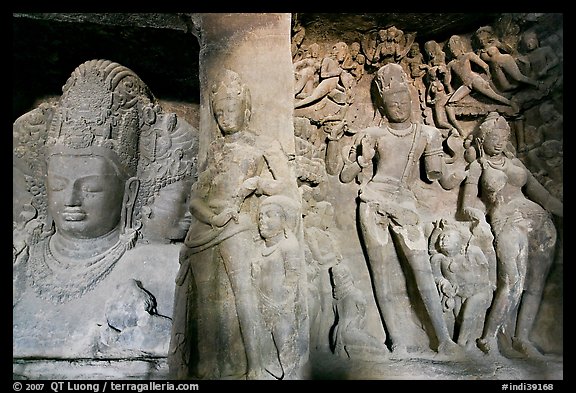
f/4.0 1/4s ISO 1600 24mm
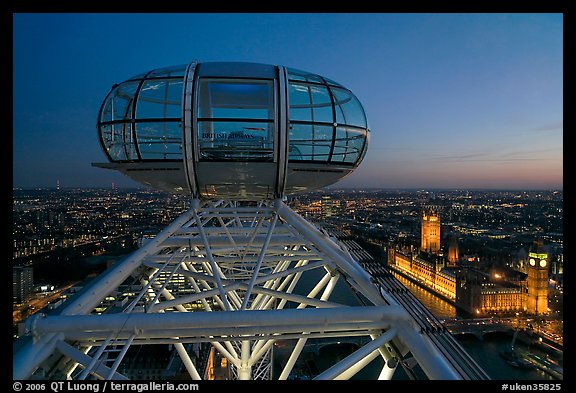
f/4.0 1/10s ISO 1600 24mm
The combination of IS and high sharpness wide open at 24mm has provided me with new opportunities. In the Elephanta Caves near Mumbai, tripods are strictly prohibited. Yet I was able to produce sharp images by hand-holding at shutters speeds of 1/4-1/8 s, shooting at 24mm wide open. A similar situation occured at dusk inside the capsule of the London Eye.


I’ve used many lens throughout my career. And Quang-Tuan, I have to agree with you that the 24-105/4 is also my favourite all purpose general lens. Excellent choice!!! And great review.
I agree, I love this lens (the 24-105), but sadly is a bit soft. I have been carrying around my D3 with the 24-70 from NIkon, and have been happier. I shoot and carry both Nikon and Canon gear
It could be that the Nikon is even sharper, but I’d certainly not call the 24-105 soft. I suspect that you got a poor sample of the lens. There is a lot of sample-to-sample variation. While replacing mine, I’ve ordered 3. See upcoming post blog with test results.
I’m interpreting your comments regarding “a lot of sample-to-sample variation” to be “laid-back.” For the money of these lenses, I’m highly dissappointed with the “quality” being produced. I have the Nikon 17-55 2.8 … and also consider it to be soft. It cost $1600 when I purchased it.
I would think that at these prices we should have the expectation that each lense be spot-on and not a crap shoot. What do you think?
See my post about sharpness measured with Imatest. My understanding is that neither Canon nor Nikon test their lenses individually, while manufacturers such as Zeiss and Leica do so. However, a Canon 20/2.8 costs $500, while a Zeiss 21/2.8 is $1500.
QT,
Thanks for this, very helpful. I’ve recently acquired the 24-105 to shoot with a 5D (Mark I) and I’m simply blown away by the combination in terms of sharpness.
Also, enjoyed your photos of Elephanta. I’d taken some photographs there some years ago using film and a Pentax SMC 28-80 (kit lens) and was naturally very disappointed. Am looking forward to seeing what the 24-105 can do at Elephanta, and your pictures are very encouraging!
This lens will be somewhat less expensive than the 24-70mm f/2.8L USM once the “new and shiny” premium has worn off. Not hugely less expensive; the slower maximum aperture makes it less expensive, but that’s probably pretty much cancelled by the extended zoom range, and IS adds a fair bit to the price. But once it’s been on the market a while, the price will fall below that of the 24-70.
I, too, am planning to replace my 28-135mm f/3.5-5.6 IS USM with the 24-105 (but not until the price falls). I found IS very useful on the 28-135 on a film body, particularly at the long end, but also sometimes at wider focal lengths. Now that I’m on a 1.6-crop body, the lens becomes more of a telephoto and IS becomes even more useful. I’m sure IS would be very useful for me on the 24-105.
I’ve just bought the 24-105/4 to create a light, carry-anywhere kit with my 5D mk II (well, light compared to a 1Ds mk II + 24-70/2.8!).
So far today I’ve done a quick test shooting my ribbed garage door, which highlights any distortion. The barelling and pincushioning are indeed pretty strong, as is the chromatic aberation. Not really good enough to wear the L designation but the trade-ff for light weight I guess. I’ve found an excellent plug-in called PTLens that automatically corrects all of this based on meta data, which I suspect will be a life saver.
[…] http://terragalleria.com/blog/2009/11/11/canon-ef-24-1054-l-is-vs-24-702-8-l/ […]
Olá! Então, comprei uma 24 105 há pouco tempo e a uso com uma 5 D e estou fascinado com o resultado, é uma objetiva muito boa mesmo…
Very interesting review.
I have both lenses. Bought the 24-105 f/4 first but do not use it much since I bought the 24-70 f/2.8 Mk II.
I am not sure the review is entirely complimentary to one lens or the other. It is very balanced and it difficult to choose. I suppose thats how it should be when comparing two good products.
By the way, I also have the 70-200 f/2.8 and mostly carry that so the extra focal length of the 24-105 is less important on most of my shoots.
I look at the two lenses like this
24-105mm f/4 L IS USM
PROS :
– Cheaper – HUGE (1150 vs 2300 USD)
– Lighter – OKAY (650 vs 805 gms)
– Has IS – IMPORTANT
– Extra Range – Could be IMP – (70-105 extra)
– Magnification – Minor (0.23x vs 0.21x)
24-70 f/2.8 mkii USM
PROS
– Sharpness – HUGE – No comparison
– Bokeh – No comparison
– Construction – IMPORTANT (Metal vs plastic) of course this means heavier
– Low Light usage – Good but helps really if using support. No IS means handholding nullifies the f/stop advantage.
– MFD Okay just two inches (18″ vs 16″)
– Flare : IMPORTANT – (very little ghosting vs Lots)
– Vignetting – IMP (Much less to none)
– Distortion – IMPORTANT (Moderate to none vs Strong to moderate)
It is important to note that I bought the Mk III version of the 24-70 which costs twice as much as the 24-105 yet I bought it and am keeping it. The reasons are above. Almost all the PROS of the 24-105 are about image quality. Since I carry my 70-200 almost all the time on a shoot the extra range is not important. But I do see the one important difference, which is the IS in the 24-105. How important is that versus the extra width of the widest aperture of the 24-70. I guess they cancel each other out if we talk of hand hold-ability and possible camera shake. But there are the other things that come with the 24-70 and many of them come from the wider aperture.
For me the faster lens, the tack sharpness, the marvellous bokeh make the 24-70 a winner. But if I was going to go into the street with just one lens which would I pick ? The correct answer is 70-200 f/2.8 because for candid photography I prefer to stay away from the subject but if not it would be a toss up I guess between these two only on the focal range.
Thanks for sharing your findings. Yes, the mk2 version of the 24-70 changes the equation.
My go to lens for many tasks. I use it for aerial photography and landscape photography. Lately, I’ve set aside my 50mm and 135mm primes and used this one for many portrait shots. I can’t see how it could be any sharper.